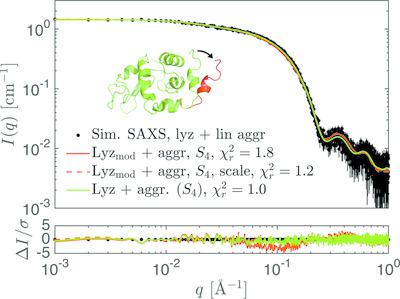当前位置:
X-MOL 学术
›
J. Appl. Crystallogr.
›
论文详情
Our official English website, www.x-mol.net, welcomes your
feedback! (Note: you will need to create a separate account there.)
Assessment of structure factors for analysis of small‐angle scattering data from desired or undesired aggregates
Journal of Applied Crystallography ( IF 5.2 ) Pub Date : 2020-07-16 , DOI: 10.1107/s1600576720006500 Andreas Haahr Larsen , Jan Skov Pedersen , Lise Arleth
Journal of Applied Crystallography ( IF 5.2 ) Pub Date : 2020-07-16 , DOI: 10.1107/s1600576720006500 Andreas Haahr Larsen , Jan Skov Pedersen , Lise Arleth

|
Aggregation processes are central features of many systems ranging from colloids and polymers to inorganic nanoparticles and biological systems. Some aggregated structures are controlled and desirable, e.g. in the design of size‐controlled clustered nanoparticles or some protein‐based drugs. In other cases, the aggregates are undesirable, e.g. protein aggregation involved in neurodegenerative diseases or in vitro studies of single protein structures. In either case, experimental and analytical tools are needed to cast light on the aggregation processes. Aggregation processes can be studied with small‐angle scattering, but analytical descriptions of the aggregates are needed for detailed structural analysis. This paper presents a list of useful small‐angle scattering structure factors, including a novel structure factor for a spherical cluster with local correlations between the constituent particles. Several of the structure factors were renormalized to get correct limit values in both the high‐q and low‐q limit, where q is the modulus of the scattering vector. The structure factors were critically evaluated against simulated data. Structure factors describing fractal aggregates provided approximate descriptions of the simulated data for all tested structures, from linear to globular aggregates. The addition of a correlation hole for the constituent particles in the fractal structure factors significantly improved the fits in all cases. Linear aggregates were best described by a linear structure factor and globular aggregates by the newly derived spherical cluster structure factor. As a central point, it is shown that the structure factors could be used to take aggregation contributions into account for samples of monomeric protein containing a minor fraction of aggregated protein. After applying structure factors in the analysis, the correct structure and oligomeric state of the protein were determined. Thus, by careful use of the presented structure factors, important structural information can be retrieved from small‐angle scattering data, both when aggregates are desired and when they are undesired.
中文翻译:

评估结构因子,以分析来自期望或不期望聚集体的小角度散射数据
从胶体和聚合物到无机纳米粒子和生物系统,聚集过程是许多系统的主要特征。一些聚集的结构是可控的,并且是可取的,例如在大小可控的簇状纳米颗粒或某些基于蛋白质的药物的设计中。在其他情况下,聚集体是不希望的,例如,涉及神经退行性疾病或体外的蛋白质聚集单一蛋白质结构的研究。无论哪种情况,都需要实验和分析工具来对聚集过程进行分析。可以使用小角度散射来研究聚集过程,但是需要对聚集体进行分析描述才能进行详细的结构分析。本文提出了一个有用的小角度散射结构因子列表,其中包括球状团簇的新型结构因子,其组成粒子之间具有局部相关性。重新对几个结构因子进行归一化,以在高q和低q极限中获得正确的极限值,其中q是散射矢量的模数。结构因素是针对模拟数据进行严格评估的。描述分形聚集体的结构因子为从线性到球形聚集体的所有测试结构提供了模拟数据的近似描述。在所有情况下,为分形结构因子中的构成粒子添加一个相关孔会显着改善拟合度。线性聚集体最好用线性结构因子来描述,球形聚集体最好用新推导的球形簇结构因子来描述。作为一个中心点,表明对于包含少量聚集蛋白的单体蛋白样品,结构因子可用于考虑聚集贡献。在分析中应用结构因素后,确定蛋白质的正确结构和寡聚状态。因此,通过仔细使用所提供的结构因子,可以从小角度散射数据中检索重要的结构信息,无论是需要聚集体还是不需要聚集体。
更新日期:2020-07-16
中文翻译:

评估结构因子,以分析来自期望或不期望聚集体的小角度散射数据
从胶体和聚合物到无机纳米粒子和生物系统,聚集过程是许多系统的主要特征。一些聚集的结构是可控的,并且是可取的,例如在大小可控的簇状纳米颗粒或某些基于蛋白质的药物的设计中。在其他情况下,聚集体是不希望的,例如,涉及神经退行性疾病或体外的蛋白质聚集单一蛋白质结构的研究。无论哪种情况,都需要实验和分析工具来对聚集过程进行分析。可以使用小角度散射来研究聚集过程,但是需要对聚集体进行分析描述才能进行详细的结构分析。本文提出了一个有用的小角度散射结构因子列表,其中包括球状团簇的新型结构因子,其组成粒子之间具有局部相关性。重新对几个结构因子进行归一化,以在高q和低q极限中获得正确的极限值,其中q是散射矢量的模数。结构因素是针对模拟数据进行严格评估的。描述分形聚集体的结构因子为从线性到球形聚集体的所有测试结构提供了模拟数据的近似描述。在所有情况下,为分形结构因子中的构成粒子添加一个相关孔会显着改善拟合度。线性聚集体最好用线性结构因子来描述,球形聚集体最好用新推导的球形簇结构因子来描述。作为一个中心点,表明对于包含少量聚集蛋白的单体蛋白样品,结构因子可用于考虑聚集贡献。在分析中应用结构因素后,确定蛋白质的正确结构和寡聚状态。因此,通过仔细使用所提供的结构因子,可以从小角度散射数据中检索重要的结构信息,无论是需要聚集体还是不需要聚集体。











































 京公网安备 11010802027423号
京公网安备 11010802027423号